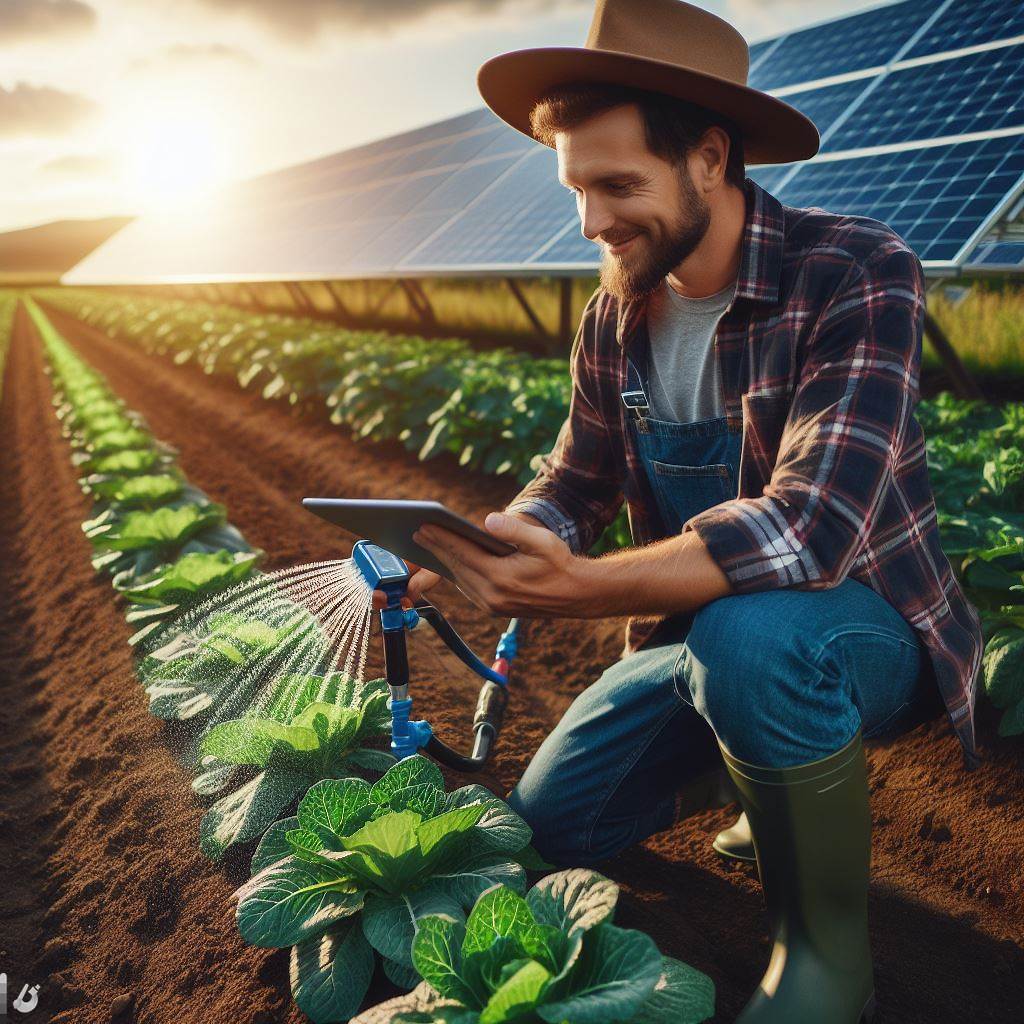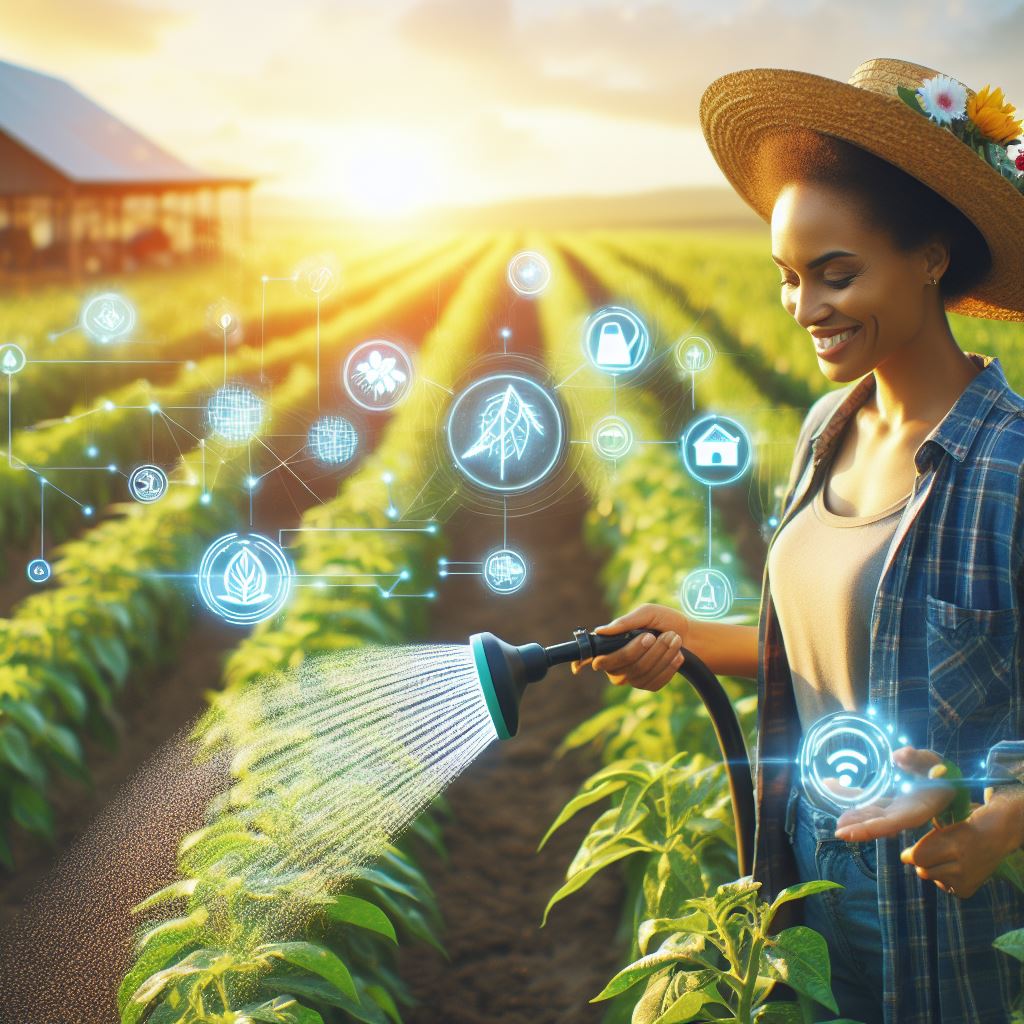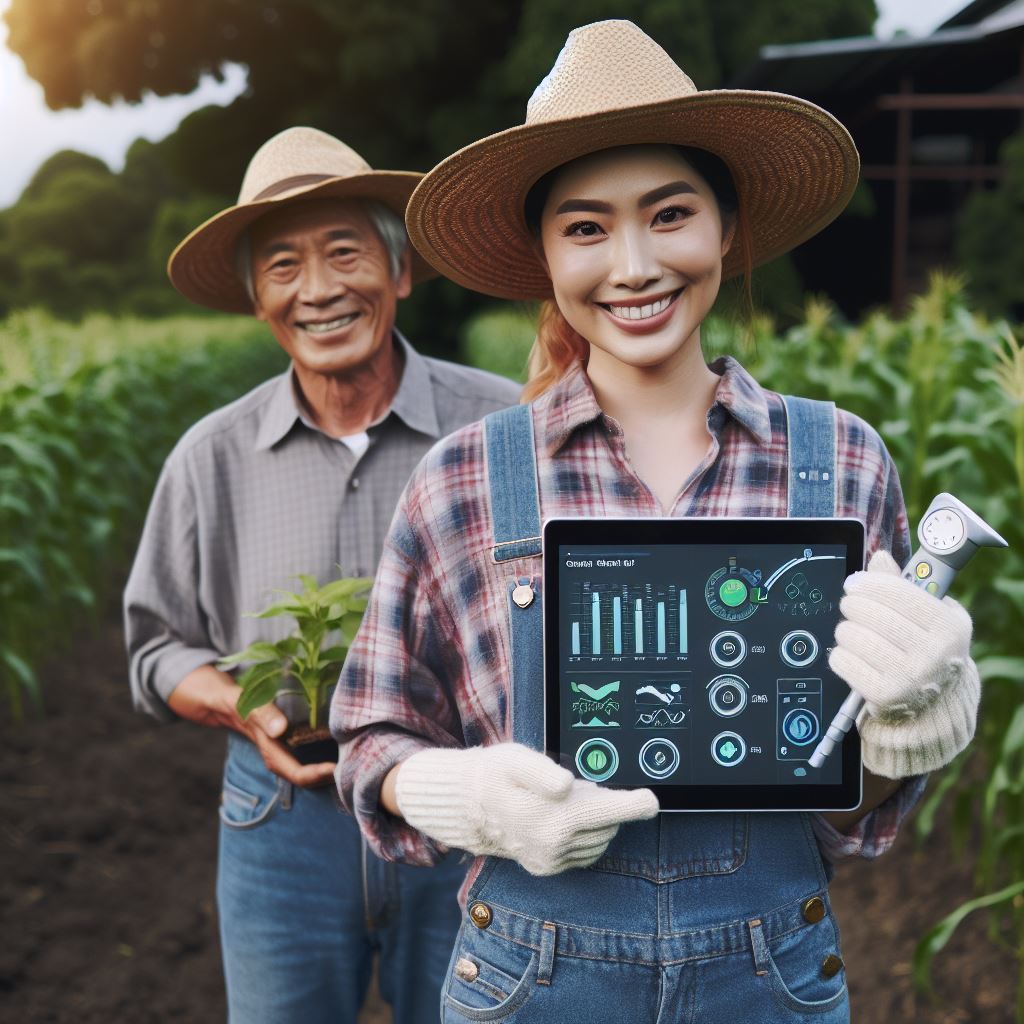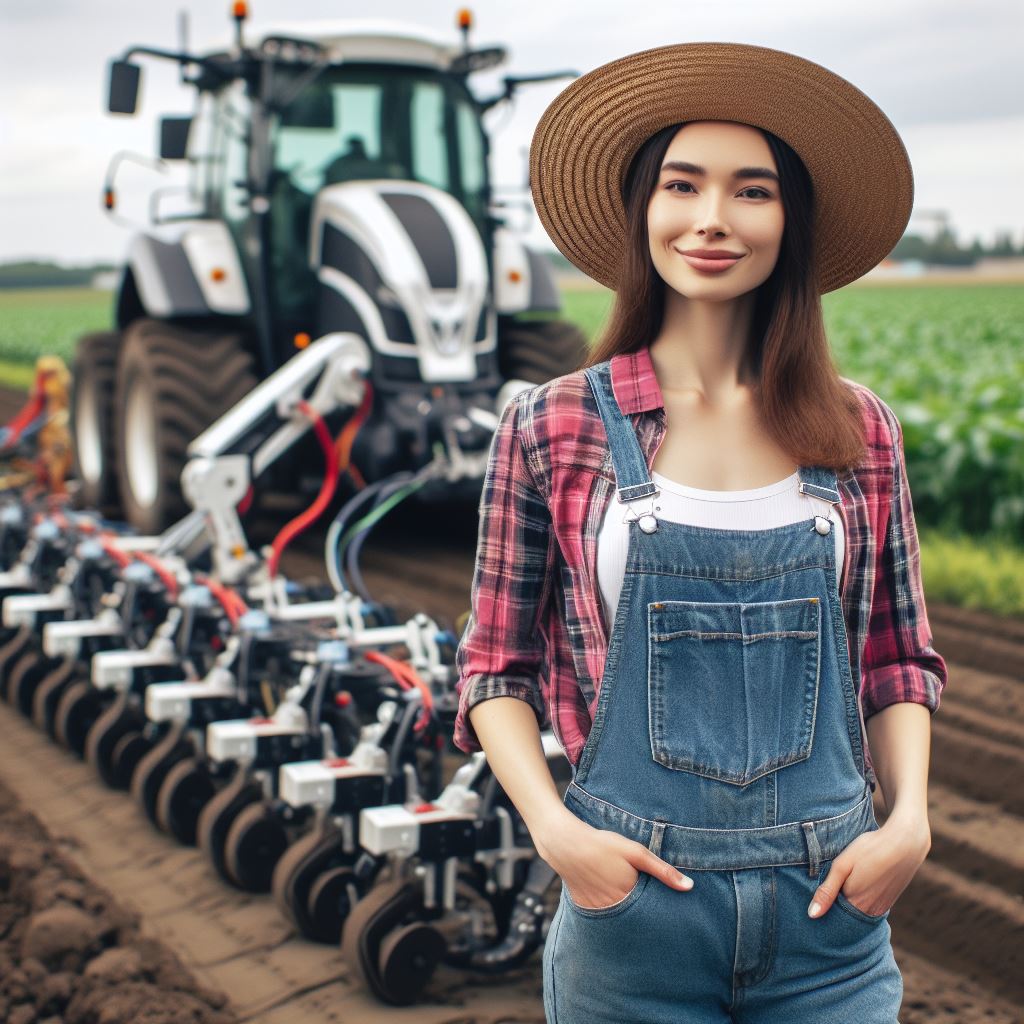Introduction
Agri robots, also known as agricultural robots, are mechanized devices used in farming operations.
These robots play a crucial role in modern farming by automating various tasks and improving efficiency.
In this blog post, we will explore the definition of agri robots, their significance in farming, and preview the main sections.
Definition of Agri Robots
Agri robots are technological devices designed to assist farmers in performing various agricultural tasks.
These robots are equipped with advanced sensors, cameras, and actuators to carry out activities such as planting, harvesting, and monitoring crops.
Importance of Agri Robots in Modern Farming
Agri robots have become increasingly important in modern farming due to their numerous advantages.
They can optimize crop yield, reduce labor costs, and minimize the use of pesticides and fertilizers.
Additionally, these robots enhance precision and accuracy, leading to better crop quality and higher productivity.
Preview of Main Sections
In the upcoming sections, we will delve into the various applications of agri robots.
First, we will discuss how these robots contribute to precision agriculture and enable data-driven farming practices.
Next, we will explore the role of agri robots in autonomous farming, where they execute tasks without human intervention.
Furthermore, we will highlight the benefits of robotic harvesting and the advancements in crop monitoring using drones.
Lastly, we will address the challenges and future prospects of agri robot technology.
Basically, agri robots are revolutionizing the farming industry by streamlining operations and maximizing crop production.
Stay tuned as we dive into the fascinating world of agri robots and their impact on modern agriculture.
Transform Your Agribusiness
Unlock your farm's potential with expert advice tailored to your needs. Get actionable steps that drive real results.
Get StartedAdvantages of Agri Robots
Agri robots offer numerous benefits that make farming more efficient, economical and productive.
Automating tasks with robots provides consistency unmatched by human workers constrained by physical limits.
Increased efficiency and productivity
Agri robots work tirelessly day and night performing tasks like seeding, weeding, inspecting and harvesting crops with reliability no human can match over long periods.
Robots also leverage AI and advanced sensors to gather data and derive insights undetectable to the human eye for improved crop quality and yields year-round.
Reduction in labor costs
Reducing manual labor significantly cuts farming costs without sacrificing productivity.
Robots can cost-effectively take over strenuous, repetitive and hazardous tasks from farm workers.
This allows farmers to cut payroll expenses and reallocate labor budget for skilled roles like equipment handling and data-driven farm management.
Enhanced precision and accuracy in farm operations
Agri robots deliver ultra-precision planting, spraying and harvesting minimizing waste.
Drift reduction nozzle technologies coupled with GPS and remote sensing allows accurate fertilizer and pesticide application only where necessary.
Automated robotic arms also pick ripe crops at optimal points without bruising fragile produce.
Ability to work in hazardous or harsh environments
Specialized agri robots function perfectly well in harsh environments like extreme heat, cold, humidity that degrade human performance and safety.
Robots can operate safely in dirty, dusty and confined livestock enclosures hazardous for people to work continuously.
This expands the operating capacity of farms tremendously.
Read: Smart Sensors: Changing Farm Water Use
Types of Agri Robots
In this section, we will explore different types of agri robots that are shaping the future of farming:
Machinery and equipment robots
- Tractors: These robots are designed to perform tasks like plowing, tilling, and hauling heavy loads on farms.
- Harvesting machines: These robots are specifically developed to automate the process of picking and collecting crops.
- Planting machines: These robots enable efficient and precise planting of seeds, ensuring optimal spacing and depth.
Autonomous robots
- Weeding robots: These robots use advanced computer vision and AI algorithms to identify and eliminate weeds without human intervention.
- Seeding robots: These robots are programmed to sow seeds in a precise manner, leading to higher crop yields.
- Crop monitoring robots: Equipped with various sensors, these robots gather essential data on crop health, moisture levels, and nutrient requirements.
- Livestock monitoring robots: These robots monitor the well-being of livestock, collecting data on their health, feeding habits, and behavior.
How Agri robots are revolutionizing the faming industry
These different types of agri robots are revolutionizing the farming industry in multiple ways:
- Increased efficiency: Agri robots automate time-consuming and labor-intensive tasks, boosting overall farm productivity.
- Precision farming: The use of robots ensures precise planting, weeding, and harvesting, leading to better crop quality and higher yields.
- Cost savings: By reducing the need for manual labor, agri robots help farmers save on labor costs, making agriculture more economically viable.
- Resource optimization: Crop monitoring robots enable farmers to make data-driven decisions, optimizing the use of water, fertilizers, and pesticides.
- Sustainability: Implementing agri robots decreases the dependency on harmful chemicals, promoting sustainable farming practices.
- Reduced environmental impact: With precise application of resources and targeted interventions, agri robots minimize wastage and environmental pollution.
Challenges that need to be addressed for the wide-scale adoption of agri-robots
However, there are challenges that need to be addressed for wide-scale adoption of agri robots:
- High initial costs: The upfront investment required for purchasing agri robots can be a significant barrier for small-scale farmers.
- Technological limitations: Agri robots need to continuously evolve to handle different crops, terrains, and weather conditions.
- Social implications: Widespread adoption of agri robots may lead to job displacement for farm laborers, requiring alternative solutions.
- Data privacy and security: The collection and use of farm data by agri robots raise concerns regarding privacy and data protection.
Essentially, agri robots have the potential to revolutionize the farming industry by improving efficiency, precision, and sustainability.
The different types of robots, ranging from machinery and equipment robots to autonomous robots, offer various benefits for farmers.
However, challenges such as high costs, technological limitations, and social implications need to be addressed to ensure widespread adoption and maximize the positive impact of agri robots in agriculture.
Read: AI in Farming: Precision Ag Revolution
Applications of Agri Robots
Agri robots have a wide range of applications in the agricultural industry, revolutionizing farming operations.
These advanced machines play a crucial role in various aspects of crop and livestock management.
Crop management
Seeding and planting
In crop management, agri robots are instrumental in improving efficiency and accuracy.
Showcase Your Farming Business
Publish your professional farming services profile on our blog for a one-time fee of $200 and reach a dedicated audience of farmers and agribusiness owners.
Publish Your ProfileSeeding and planting crops require precision, and agri robots excel at this task.
They can navigate fields autonomously, ensuring crops are sown at the right depth and spacing.
This eliminates human error and increases productivity.
Crop monitoring and disease detection
Crop monitoring and disease detection are other important applications of agri robots.
These robots are equipped with sensors and cameras that can assess plant health and identify any signs of disease or stress.
Early detection allows farmers to take prompt action, preventing the spread of diseases and minimizing yield loss.
Irrigation systems
Moreover, agri robots can be utilized in irrigation systems.
They can automate the process by assessing soil moisture levels and applying water accordingly.
This helps conserve water resources and promotes efficient use of irrigation systems.
By optimizing water usage, farmers can achieve higher crop yields while minimizing environmental impact.
Livestock management
Monitoring the health and behavior of animals
In livestock management, agri robots have proven to be invaluable.
Monitoring the health and behavior of animals is crucial for ensuring their well-being.
Agri robots equipped with sensors can provide real-time data on animal health, allowing farmers to detect early signs of illness and provide appropriate care.
This saves time and resources, as potential issues can be addressed promptly.
Feeding and milking robots
Feeding and milking robots have also transformed the livestock industry.
These robots automate the process, ensuring consistent feeding and milking routines.
They can accurately measure and dispense feed, reducing waste and optimizing nutrition.
Similarly, milking robots are capable of efficiently milking cows, minimizing labor requirements and maximizing milk production.
Herding and mustering robots
Additionally, herding and mustering robots are used to manage livestock on farms.
These robots can safely gather, drive, and separate animals without human intervention.
They improve efficiency and safety while reducing the stress on both animals and farmers.
Agri robots have made livestock management easier and more effective.
In essence, agri robots have revolutionized farming practices with their wide range of applications.
Whether it is crop management or livestock management, these advanced machines offer precision, efficiency, and automation.
From seeding and planting to disease detection and irrigation, agri robots optimize resource usage and improve productivity.
They are the future of farming, enhancing sustainability and addressing the challenges of modern agriculture.
Read: Tech Trends: Agri Robotics in 2024
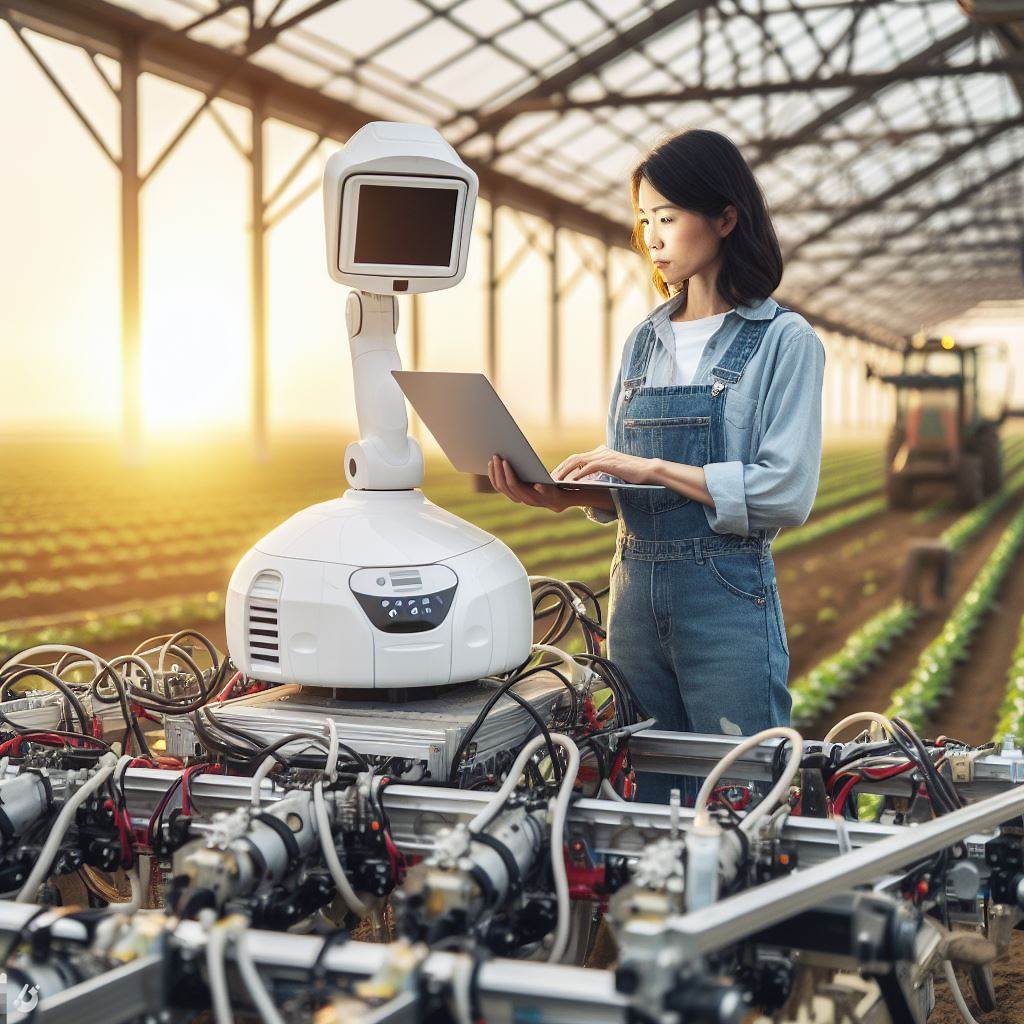
Impact of Agri Robots on Farming
Increased efficiency and profitability for farmers
Agri robots increase efficiency and profitability for farmers as these tireless machines can cultivate lands 24/7, enabling farmers to produce higher yields with fewer resources.
GPS-enabled precision planting robots can sow seeds more efficiently, reducing wastage.
Autonomous crop monitoring robots scan fields continually to identify crop risks early.
Automated fruit picking robots are faster and more consistent than human laborers. Overall, agri robots lower labor, fuel and maintenance costs over time.
Reduction in manual labor requirements
Robots significantly reduce strenuous manual labor like lifting, bending and carrying heavy loads.
Robotic fruit pickers, weeding robots, autonomous seeders and fertilizer applicators take over back-breaking tasks from farm workers.
Milking robots milk more cows in less time with lower labor.
This enables farmers to focus more on managerial duties like data analysis to derive actionable insights.
It also makes the farming occupation more appealing to younger generations.
Preservation of soil health and reduction in chemical use
Advanced AI-based computer vision, spectral imaging and sensors allow agri robots to detect subtle crop variations invisible to the human eye.
This allows precise, variable-rate irrigation and application of nutrients, pesticides and herbicides minimizes run-off. GPS-enabled robots also till soil evenly without over-compaction.
All this preserves long-term soil viability.
Improved quality and consistency of crops and livestock
Robots provide consistent quality monitoring and output 24/7.
Showcase Your Farming Business
Publish your professional farming services profile on our blog for a one-time fee of $200 and reach a dedicated audience of farmers and agribusiness owners.
Publish Your ProfileVision-based fruit harvesters only pick ripe produce at optimal sweetness.
Livestock robots monitor cattle body temperature, movement patterns and feed levels optimally for growth, milk production and breed improvement without human errors.
Potential challenges and concerns
High costs of agri robots make access difficult for small farms.
Integrating complex robots with outdated farm equipment can be challenging.
Regular maintenance of sophisticated robots may require specialized technicians.
Proper farmer training is essential to leverage the full benefits.
There are also concerns around data privacy, safety, potential job losses and over-reliance on technology.
Regulations and incentives may be needed for balanced adoption.
Read: Precision Agri: GPS Guided Farming Explained
Future Developments and Trends
The field of agri-robotics is constantly evolving, with ongoing research and development pushing the boundaries of what these machines can achieve.
As technology advancements continue to accelerate, future developments and trends in agriculture robots hold great promise for the industry.
Integration of artificial intelligence and machine learning
One significant trend is the integration of artificial intelligence (AI) and machine learning (ML) into agricultural robots.
AI algorithms can be used to analyze vast amounts of data, enabling robots to make more informed decisions and perform complex tasks with precision.
With ML, agri robots can continuously learn and improve their performance over time, adapting to changing farming conditions and optimizing their operations.
Swarm robotics for collaborative farm tasks
Another exciting area of exploration is swarm robotics. Instead of relying on a single, large robot, swarm robotics involves the coordination of multiple small robots working together as a team.
These robots can collaborate on tasks such as planting, weeding, and harvesting, making the farming process more efficient and reducing the need for manual labor.
Swarm robotics also offers redundancy, as if one robot fails, the others can continue working, minimizing the impact on productivity.
Adoption of sensor technologies for data collection and analysis
Sensor technologies are also being increasingly adopted in agri robots for data collection and analysis.
These sensors can gather information about soil moisture levels, temperature, pest infestations, and crop growth.
The collected data is then processed and analyzed to provide valuable insights for farmers, allowing them to optimize irrigation, detect diseases early on, and make informed decisions about their crops.
This data-driven approach to farming leads to more precise and sustainable agricultural practices.
Autonomous drones for crop spraying and monitoring
Autonomous drones are another technology on the rise in the agriculture industry.
These drones can be programmed to perform tasks such as crop spraying and monitoring, eliminating the need for manual labor and reducing the use of chemicals.
Autonomous drones can quickly cover large areas, providing efficient and targeted treatments to crops.
They can also collect high-resolution imagery of fields, helping farmers identify problem areas and take timely actions.
Bio-inspired robots for pollination
One area where agri robots are taking inspiration from nature is pollination.
With the decline in natural pollinators, bio-inspired robots are being developed to fulfill this crucial role.
These robots mimic the behavior of bees and other pollinators, helping to pollinate crops and maintain high yields.
By leveraging these bio-inspired robots, farmers can ensure that their crops are adequately pollinated, leading to better harvests and increased food production.
In a nutshell, future developments and trends in agri robots encompass integrating AI and ML, deploying swarm robotics, adopting sensor technologies, utilizing autonomous drones, and leveraging bio-inspired robots.
These advancements have the potential to revolutionize farming practices, making them more efficient, sustainable, and resilient.
With the constant evolution of technology, the future of farming is now, and agri robots play a pivotal role in shaping it.
Conclusion
We have discussed the main points regarding agri robots and their transformative role in modern farming.
These robots have revolutionized agricultural practices by increasing efficiency, reducing labor costs, and improving crop yields.
The potential for further advancements in agri robot technologies is immense, and it is crucial to encourage further research and investment in this field.
By doing so, we can ensure sustainable and efficient farming practices for future generations.

